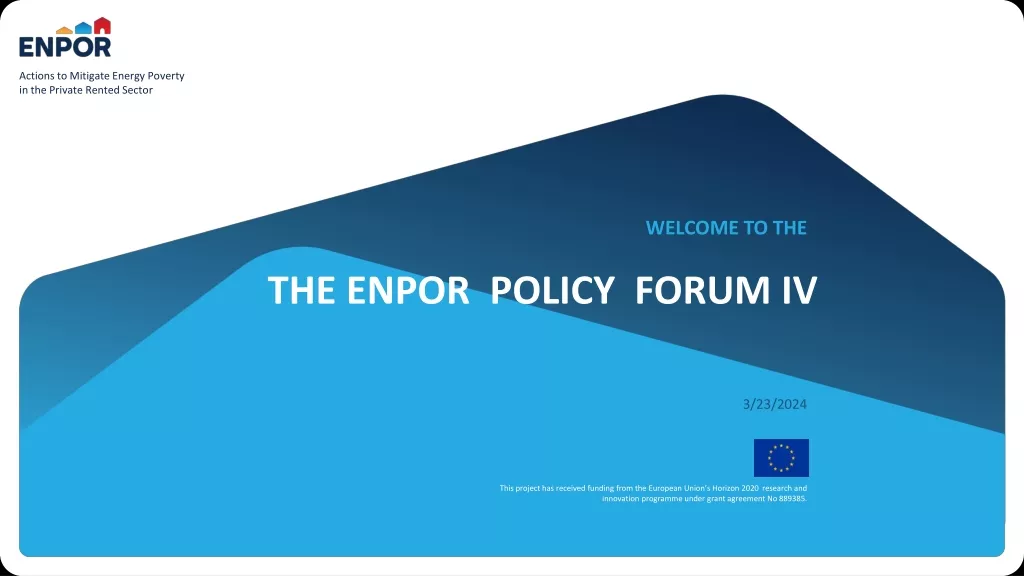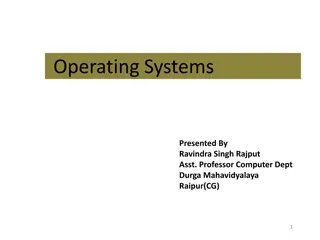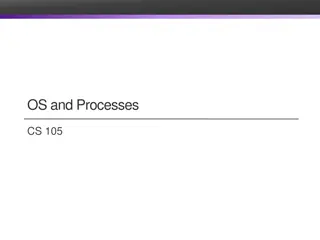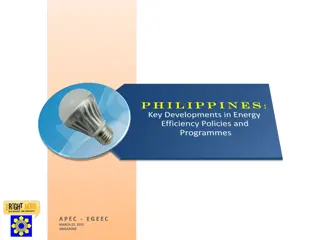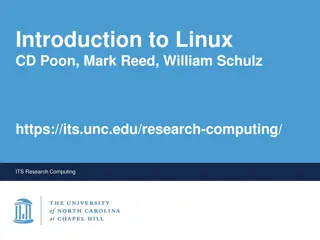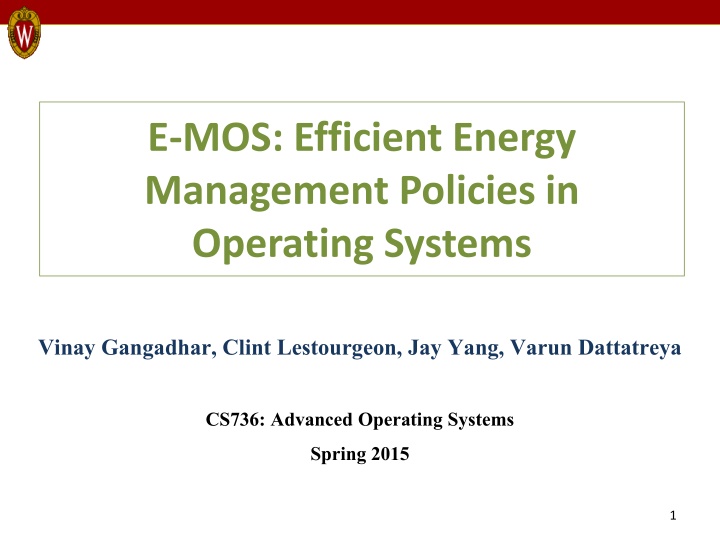
Efficient Energy Management Policies in Operating Systems
This project focuses on evaluating existing Linux power management mechanisms to make application-aware energy-efficient policy decisions. It discusses system power management, levels of power management, Linux power governors, and application categorization & analysis.
Download Presentation

Please find below an Image/Link to download the presentation.
The content on the website is provided AS IS for your information and personal use only. It may not be sold, licensed, or shared on other websites without obtaining consent from the author. If you encounter any issues during the download, it is possible that the publisher has removed the file from their server.
You are allowed to download the files provided on this website for personal or commercial use, subject to the condition that they are used lawfully. All files are the property of their respective owners.
The content on the website is provided AS IS for your information and personal use only. It may not be sold, licensed, or shared on other websites without obtaining consent from the author.
E N D
Presentation Transcript
E-MOS: Efficient Energy Management Policies in Operating Systems Vinay Gangadhar, Clint Lestourgeon, Jay Yang, Varun Dattatreya CS736: Advanced Operating Systems Spring 2015 1
System Power Management Computing Platforms Power Management (PM) problem Takeaway Mobile and Embedded Devices 1. Better Control on System Power Consumption 2. Policy decisions favoring Energy Efficient Computing Desktop Systems But wait!! Who has the control ? Server Environment 2
Levels of Power Management Coarse Fine Control KERNEL POWER GOVERNORS P-STATE DRIVERS HARDWARE Workload Awareness High Low 3
Our Project Evaluate existing Linux PM mechanisms Application-aware energy efficient policy decisions E-MOS model Evaluate E-MOS using User-Space power governors 4
Outline Introduction Linux Power Governors Case Study Application Categorization & Analysis E-MOS Model Evaluation & Results Lessons Learnt & Conclusion 5
Linux Power Governors CPUFreq Intel P-State Governors Governors Ondemand Conservative PowerSave PowerSave Performance Performance Userspace Architecture Independent Architecture Dependent CPUFreq module Intel P-State driver Core frequency setting Core frequency setting
Applications Compute Intensive CPU Core Takeaway Cache Sensitive 1. Cannot apply same policies to all workloads !! 2. Need Application-aware energy management policy Memory Intensive decisions I/O Intensive 8
Imperfect Scaling Case study Expectation: High CPU usage Performance should scale with CPU frequency Problem: Cache misses Memory is fast But not fast enough Existing Solutions Better Programming skills Modern Computer Architecture improvements 9
Application Categorization PIN Based Modeling SPEC2K6 Compute SPLASH2 Compute + Cache MICRO-BENCH Cache + Memory 11
Power Governors Analysis SPEC2K6 Compute Intensive SPLASH2 Cache Sensitive MICRO-BENCH Memory Intensive 12
Power Governors Analysis SPEC2K6 Compute Intensive Takeaway Default power governors SPLASH2 Cache Sensitive 1. Don t provide better energy efficiency Optimized only for Compute workloads!! 2. Don t rely on application characteristics to make MICRO-BENCH Memory Intensive better policy decisions 3. OS can relinquish freedom to User space for better energy management 13
E-MOS Analytical Model RAPL Running Average Power Limit Profiled Application Information Perf Linux utility for performance measurements CPUPower Utility for frequency measurement RAPL + Perf + CPUPower Application-aware Energy Policy E-MOS Analytical Model Reduce Freq. by 5%, 10%, , 25% steps Increase Freq. by 5%, 10%, , 25% steps - + User-Space Power Governor Energy Estimates for CPU cores 14
E-MOS Decision Table Example Reduce Core Freq. by 25% Increase Core Freq. by 25% Application Objective CPU Freq. DRAM Freq. Compute Intensive Energy Maintain/Increase Decrease Performance Increase Maintain Cache Sensitive Energy Decrease Decrease Performance Maintain Increase Memory Intensive Energy Decrease Maintain/Increase Performance Maintain Increase 15
Evaluation Platform: Kernel: Linux 3.14 CPU: Intel core i7 3630M Scaling frequencies (Ghz): 0.8, 1.2, 1.5, 1.8, 2.1, 2.4, 3.4 (turbo) Energy & timing measurement: Perf (RAPL interface) Power and Performance measurements CPUPower Frequency Setting 16
Results - 1 Compute Intensive workloads -- SPEK2K6 E-MOS Frequency Setting chosen 1.8Ghz to 2.4Ghz With 2.4Ghz 1.44x (44%) Energy Efficiency with Performance loss of 3% 17
Results - 2 Compute Intensive + Cache Sensitive workloads -- SPLASH2 E-MOS Frequency Setting chosen 1.8Ghz to 2.1Ghz With 1.8Ghz 1.61x (61%) Energy Efficiency with Performance loss of 9% 18
Results - 3 Memory Intensive workloads -- MICRO-BENCH E-MOS Frequency Setting chosen 1.2Ghz to 1.8Ghz With 1.2Ghz 2x (200%) Energy Efficiency with Performance loss of 13% 19
Lessons Learnt Power estimation is challenging but the tools are getting better Performance benchmarks may not be the best way to evaluate power management Based on our results, P-state drivers may not be as awesome as Intel would have you believe Intel s most useful P-state documentation is a Google+ post !! 20
Conclusion Application-aware energy management Energy as a first class resource EMOS achieves upto 2x energy efficiency with performance loss of 13% Power governors can take advantage of reducing CPU frequency for Memory bound applications User-space power governors with more runtime library support can be more efficient than Ondemand 21
Power Governors Optimized for Compute workloads Energy = Power X Time Benchmarks: SPEC CPU2006, Splash2, Micro benchmarks 23
ACPI Interface Applications OS Power Management ACPI Software drivers Hardware: CPU, BIOS etc. 24
Problem with Power Governors Power management tends to be simplistic Most policies use race to halt approach Run the workload to completion at the maximum performance setting and then transition into a low-power mode Assumes that the highest energy savings can be achieved by running at the lowest performance setting Either statically scale the CPU frequency or provide limited CPU capability to define energy requirements of an application Use only CPU usage as source of information What about memory bound applications? Do not provide a fine-grained control and management over the energy utilized by the applications


